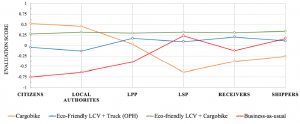Successful delivery consolidation strategies could be a trade-off between transshipment and distribution costs, externalities, the interest of stakeholders and the formulation of required and supporting regulations and incentives.
In the end, the various stakeholders need to take these aspects into consideration when assessing and selecting the type and mix of freight vehicles to perform the consolidated deliveries in the congested inner-city area, which underlines the difficulties associated with freight consolidation policies.
Consequently, the optimal configuration for the consolidated delivery fleet should address the sustainable, societal, economic and operational objectives and requirements by all the stakeholders in a balanced approach.
MAMCA framework
A research paper by the University of Melbourne utilized the MAMCA framework to evaluate the suitability and practicality of various freight vehicles to conduct the consolidated deliveries in the inner-city area with respect to their potential in achieving the various objectives of all stakeholders involved in last mile delivery.
The researchers made an effort to ensure including relevant and practical objectives that might be very important in reality for the stakeholders in their decision-making with respect to freight consolidation policies. The allocated criteria weights highlighted how stakeholders differed in their perspectives on the optimal delivery fleet for the consolidated deliveries. Different stakeholder groups assigned conflicting scores for shared objectives. However, some criteria were prevalent for most stakeholders, primarily the transport cost for business stakeholders and liveability for societal stakeholders.
The multi-criteria analysis produced a ranking of the various alternatives as well as in-depth understanding of how each alternative was viewed by each stakeholder group. This clearly highlighted how the objectives of the six stakeholder groups result in different and clashing views of each alternative. The study attempted to delve more into the mono-actor analysis than other studies that utilized the MAMCA framework to acquire more individual perspectives from the clashing stakeholders. The mono-actor analysis provided new insights on why some business stakeholders might reject cargo bikes as they adversely affect the efficiency of their operations.
No single solution
An important lesson is that there is no single solution that could address or satisfy all the objectives of all the various stakeholders. This further raises the need for researchers and policy-makers to avoid focusing only on most visible or influential stakeholders in last mile delivery and ensure incorporating the objectives and requirements of all stakeholders.
The combined use of eco-friendly delivery vans and cargo bikes represented the consolidated delivery fleet configuration with the best chance of receiving consensus based on all the stakeholders’ preferences. It offered a sustainable delivery fleet that addresses the concerns and requirements of all stakeholder groups. Performing consolidated deliveries in the inner-city area using battery electric delivery vans and cargo bikes contributes to reducing emissions, noise and traffic congestion around receivers, especially in heavily dense and congested areas. This enhances the amenity of the area and quality of life for customers, retailers, and residents.
Perspectives of participatory decision support
The insights and perspectives on the four scenarios acquired from the six stakeholder groups by the MAMCA framework provide the local authorities and transport scholars with valuable information that could be used to formulate suitable and sustainable freight solutions and policies to address the challenges and negative impacts of last mile delivery in the inner-city area.
The participatory decision support approach could be utilized by local authorities to act proactively and set policies that promote and support freight carriers to utilize eco-friendly vehicles. It is recommended that local authorities assess the merits and associated costs of applying the implementation plan to set up a suitable consolidation facility and establish a Public Private Partnership (PPP) with a leading freight carrier to operate the consolidation facility. The PPP agreement should set clear objectives and performance-zoning codes to be met by the consolidation facility operator to perform the consolidated deliveries by battery electric vehicles and cargo bikes to receivers in the inner-city area.
Using MAMCA
With the inclusion of the perspectives of local authorities and citizens, local authorities could use this framework as a lobbying tool to justify preserving industrial lands and setting supporting policies to establish future consolidation facilities in the inner-city area. Managers of delivery companies could utilize the proposed implementation plan for setting up and operating suitable and sustainable consolidation facilities in the congested central city area that takes into consideration their operational and locational requirements as well as a sustainable delivery fleet. In order to reduce the additional transshipment and consolidation costs, it is essential for participating freight carriers to increase the vehicle fill-rate of their incoming vehicles to the consolidation facility through palletization of parcels and the use of large trucks.
Source:

